Largest Escher exhibition ever opened in Rome
100 years after his first visit to the capital in 1923, Escher returns to Rome with the largest and most comprehensive exhibition ever dedicated to him, at the Palazzo Bonaparte. Maurits Cornelis Escher (Leeuwarden, 1898 - Hilversum, 1972), one of the world’s most beloved artists to the general public, moved to Rome in 1923. A restless, reserved and undoubtedly brilliant Dutchman, Escher is the artist whose etchings and lithographs have had and continue to have the unique ability to transport us into an imaginative and impossible world where art, mathematics, science, physics and design are mixed. An artist discovered relatively recently, Escher has captivated millions of visitors around the world because of his ability to speak to a wide audience. Escher is loved by those who know art, but also by those who are passionate about mathematics, geometry, science, design, and graphics. A wide range of themes converge in his works, and for this reason in the panorama of art history he represents a unicum.
The exhibition in Rome takes the form of an exceptional event that presents to the public, in addition to his most famous masterpieces, numerous never-before-exhibited works. An anthological exhibition of some 300 works that includes the now iconic Hand with Reflecting Sphere (1935), Bond of Union (1956), Metamorphosis II (1939), Day and Night (1938), the celebrated Emblemata series, and many, many more. Also embellishing the exhibition tour is a reconstruction of the studio Escher had in Baarn, Holland, which, here in Rome, displays inside it the various original tools with which the Master produced his works and the portable easel that Escher himself brought with him on his wanderings through Italy.
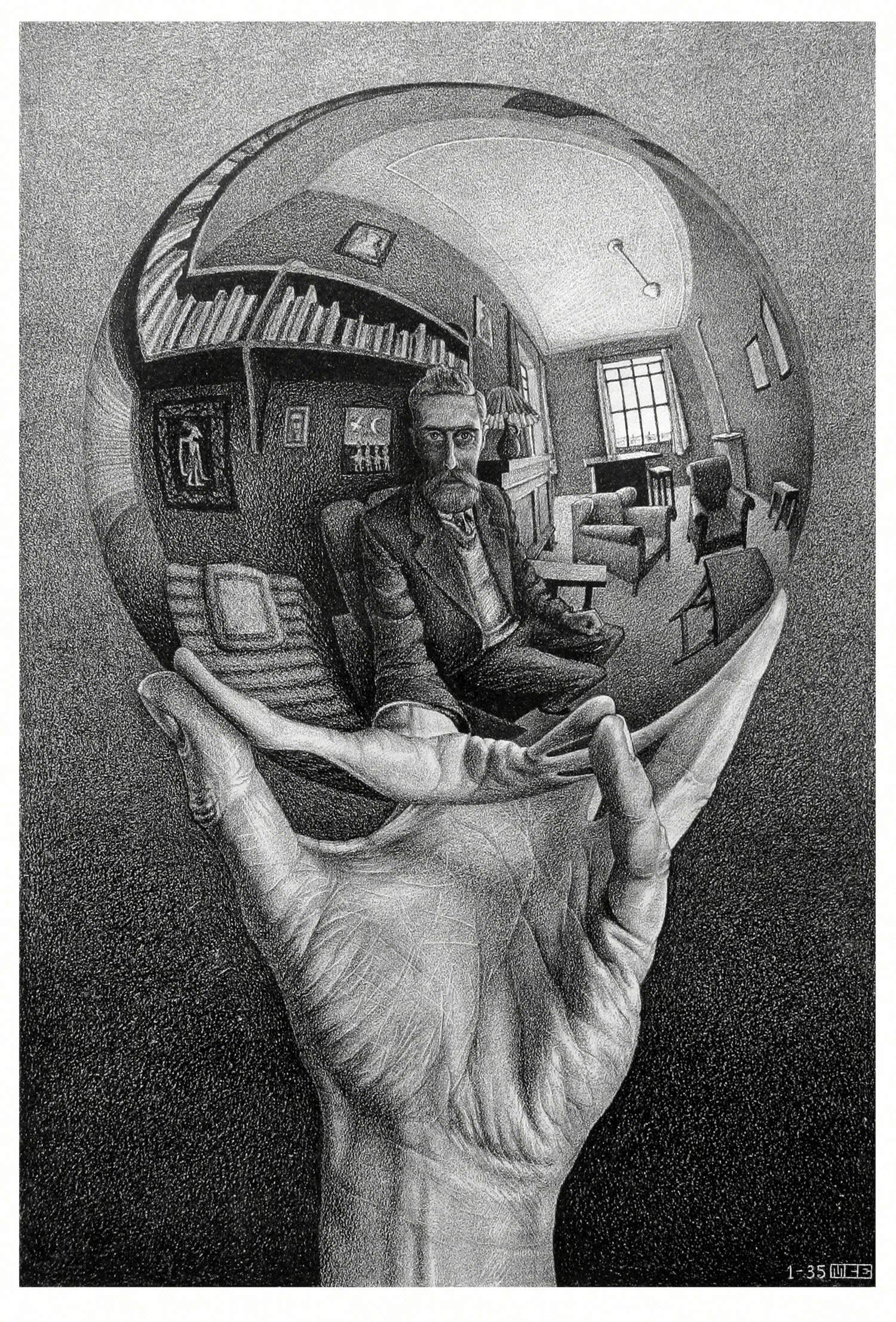
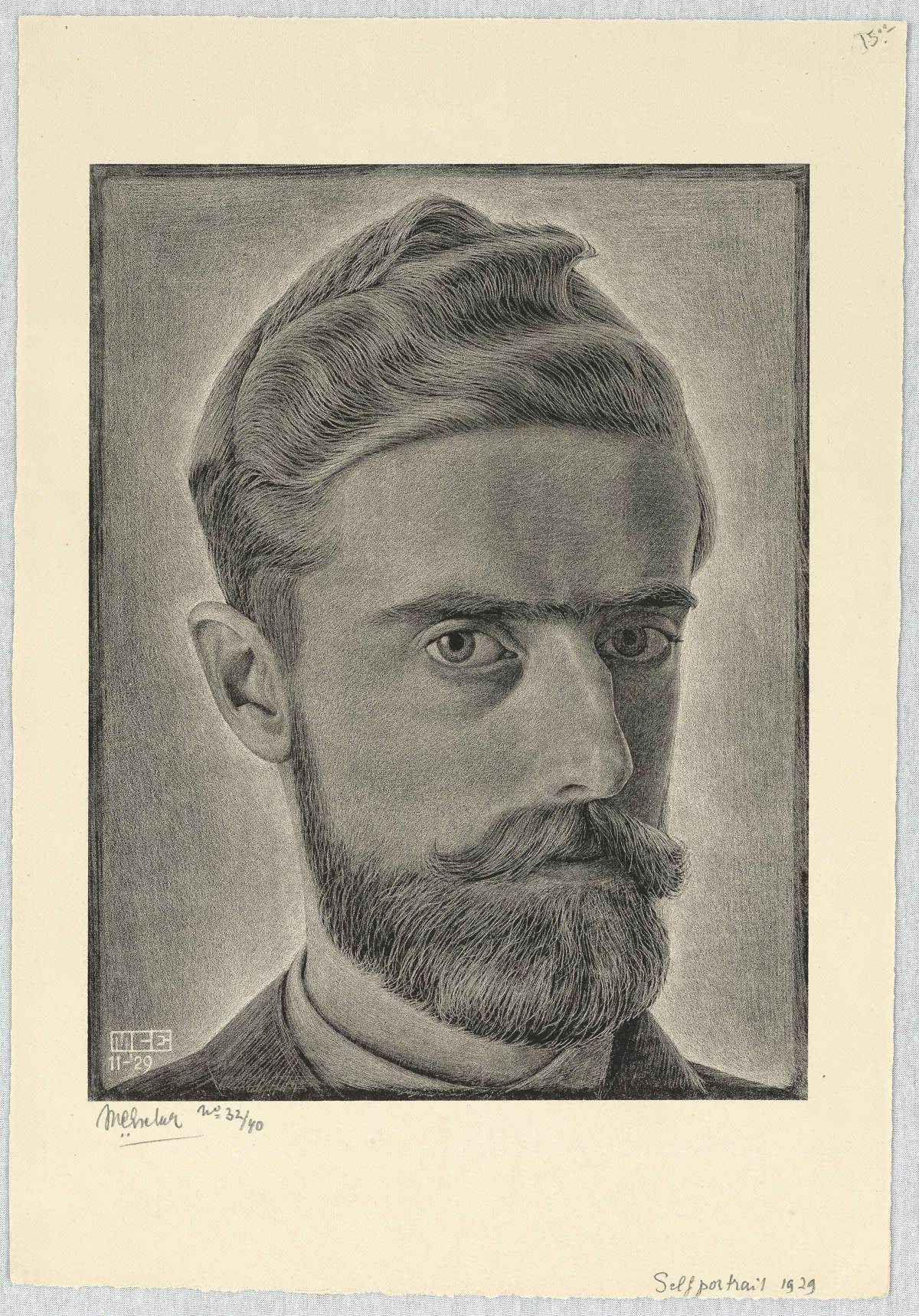
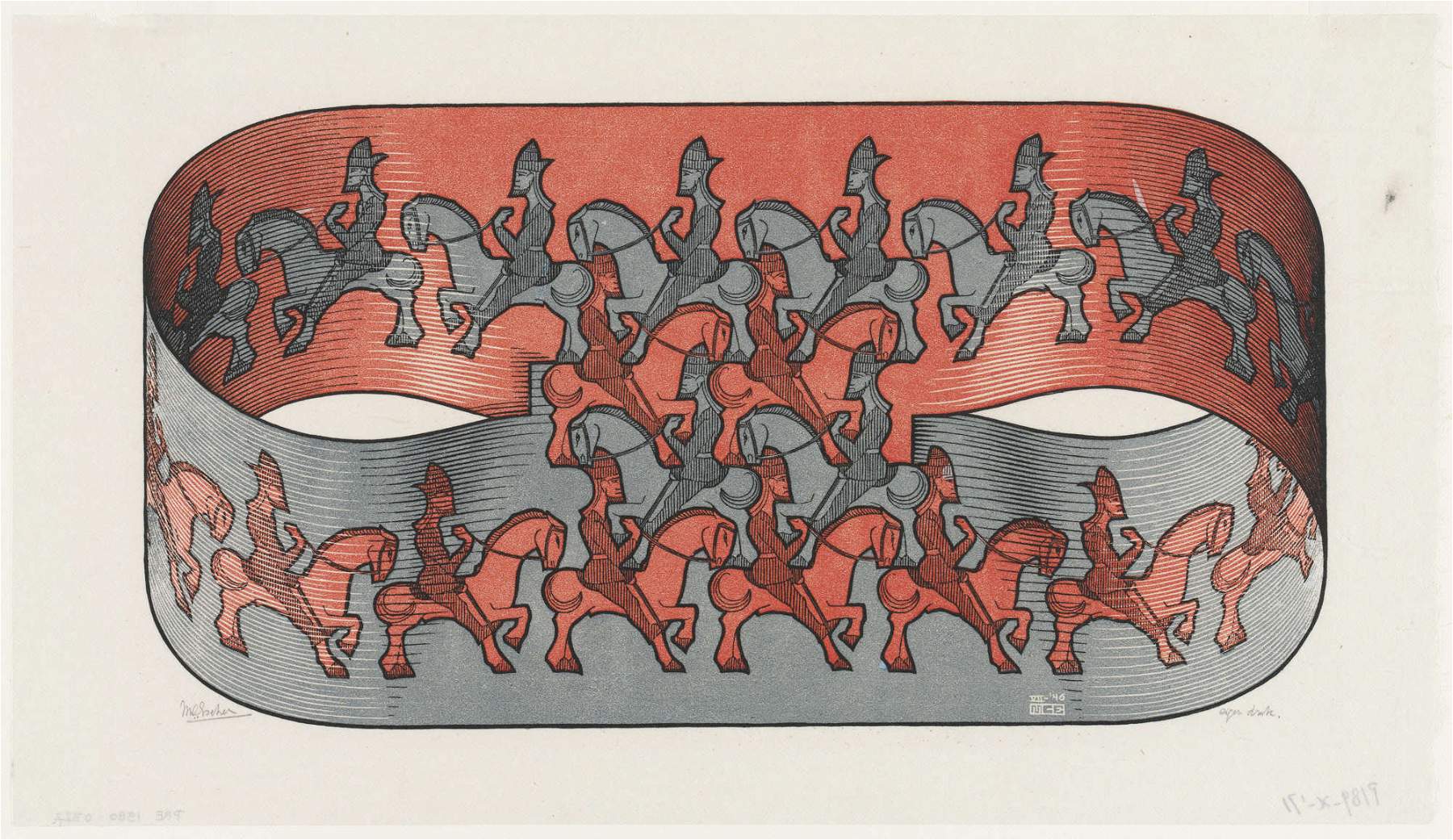
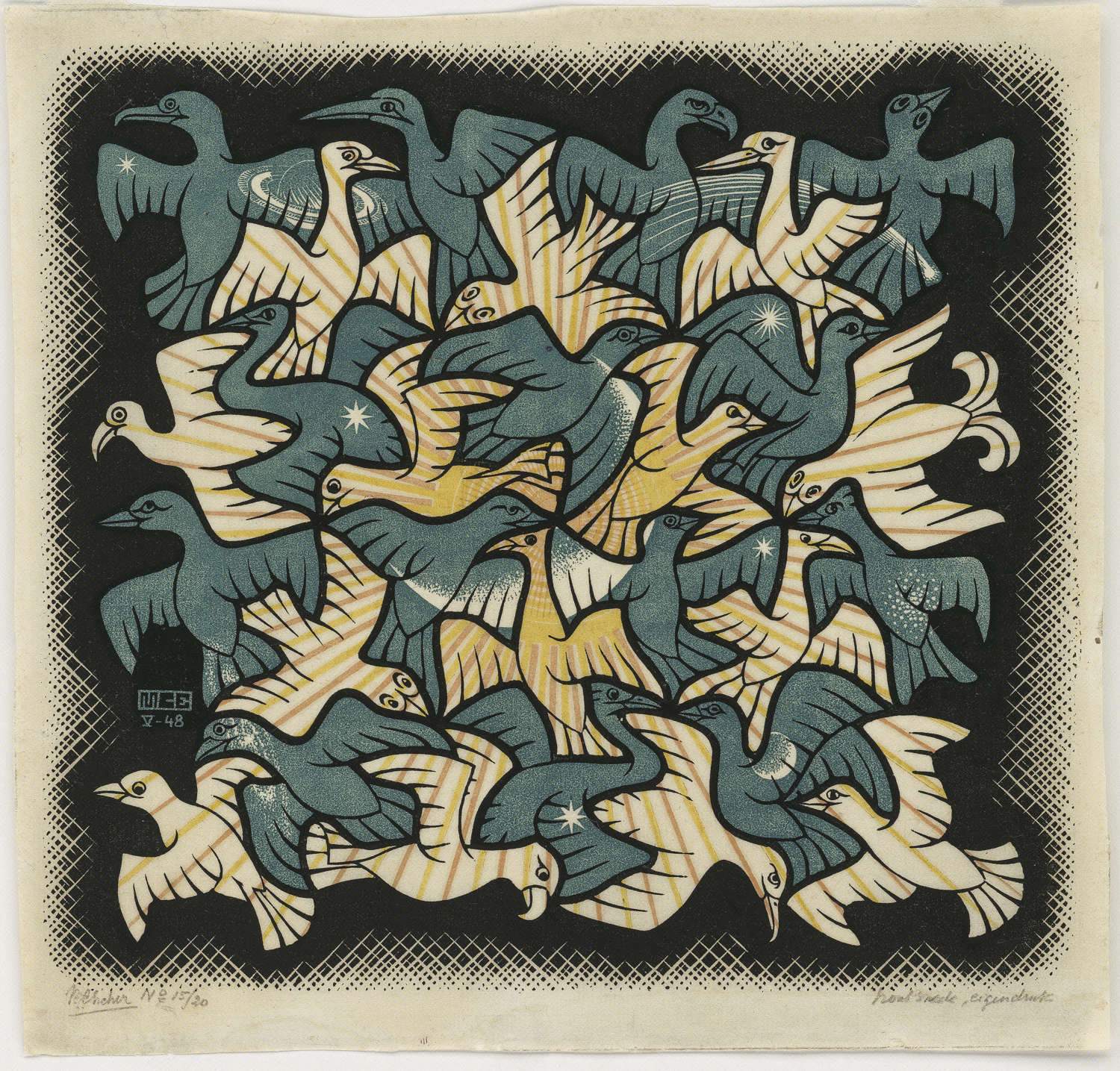
After several trips to Italy that began in 1921 when he visited Tuscany, Umbria and Liguria, Escher arrived in Rome where he lived for a full twelve years, from 1923 to 1935, at 122 Via Poerio in the Monteverde vecchio district. The Roman period had a strong influence on all his later work, which saw him prolific in the production of lithographs and engravings especially of landscapes, views, architecture and views of that ancient and Baroque Rome that he loved to investigate in its most intimate dimension, that of the night, in the dim light of a lantern. The nights spent drawing, sitting on a folding chair and with a small flashlight hanging from his jacket, are counted by Escher among the best memories of that period.
In fact, the exhibition at Palazzo Bonaparte will also feature the complete series of 12 “Roman Nocturnes” produced in 1934 - including Colonnade of St. Peter’s, St. Nicholas in Prison, Small Churches, Piazza Venezia, St. Frances Roman,The dioscuro Pollux-along with other works depicting the splendors of ancient Urbe such as Rome (and the Borghese Griffin) from 1927, San Michele dei Frisoni, Rome (1932) and Between St. Peter’s and the Sistine Chapel (1936).
The sections of the exhibition
First section - The Beginnings
Samuel Jesserun de Mesquita (1868 - 1944) was an exponent of the Dutch Art Nouveau movement. He was Escher’s teacher at the School of Architecture and Decorative Arts in Haarlem and encouraged him to become a graphic designer. Escher’s early work is thus influenced by Art Nouveau, a current characterized by sinuous, elegant forms and decorative ornaments inspired by natural subjects. The artist always had a deep interest in nature and made numerous prints with realistic depictions of flowers and insects. From 1922 to 1935, Escher undertook multiple trips to the Belpaese, drawing monuments, landscapes, flora and fauna, which he transformed into graphic works upon his return to the studio. In these works, mostly characterized by unusual perspectives, a meticulous observation of nature already blends with views that sweep to distant horizons, almost anticipating the perspective paradoxes and optical illusions of his maturity. Also reproduced in this section are the 28 woodcuts that make up the book XXIV Emblemata dat zijn zinne-beelden, that is, XXIV Emblems, with maxims in verse, one of Escher’s three works as an illustrator.
Second section - Italy
From 1922 to 1935, Escher stayed in Italy, moving permanently to Rome from November 1923. The Eternal City represents an important part of the body of his works; in addition to various monuments and views of the city, we are left with a series of 12 masterful woodcuts, made from sketches sketched at night thanks to a flashlight and a travel easel. Another reference to that period, for example, is found in the famous work Hand with Reflecting Sphere where his studio at 122 Via Alessandro Poerio is faithfully reproduced. Every year Escher embarked on a journey through Italy and the Mediterranean to reproduce its magnificent landscapes-Campania, Calabria, Sicily, Abruzzo, etc.-often in the company of his friend and Swiss artist Giuseppe Haas Triverio. Following the growing oppression of the fascist movement, he moved first to Switzerland in 1935, then in 1937 to Uccle in Belgium, and finally in 1941 to Baarn in the Netherlands. That between Escher and Italy is an unbreakable bond. In Italy he probably lived his happiest years: here he married, started a family and reaped his first professional successes; this transpires from his diaries, photographs but above all from his works. Even after his artistic turn toward abstract subjects, we find frequent evocations of the Italian landscape in his image composition.
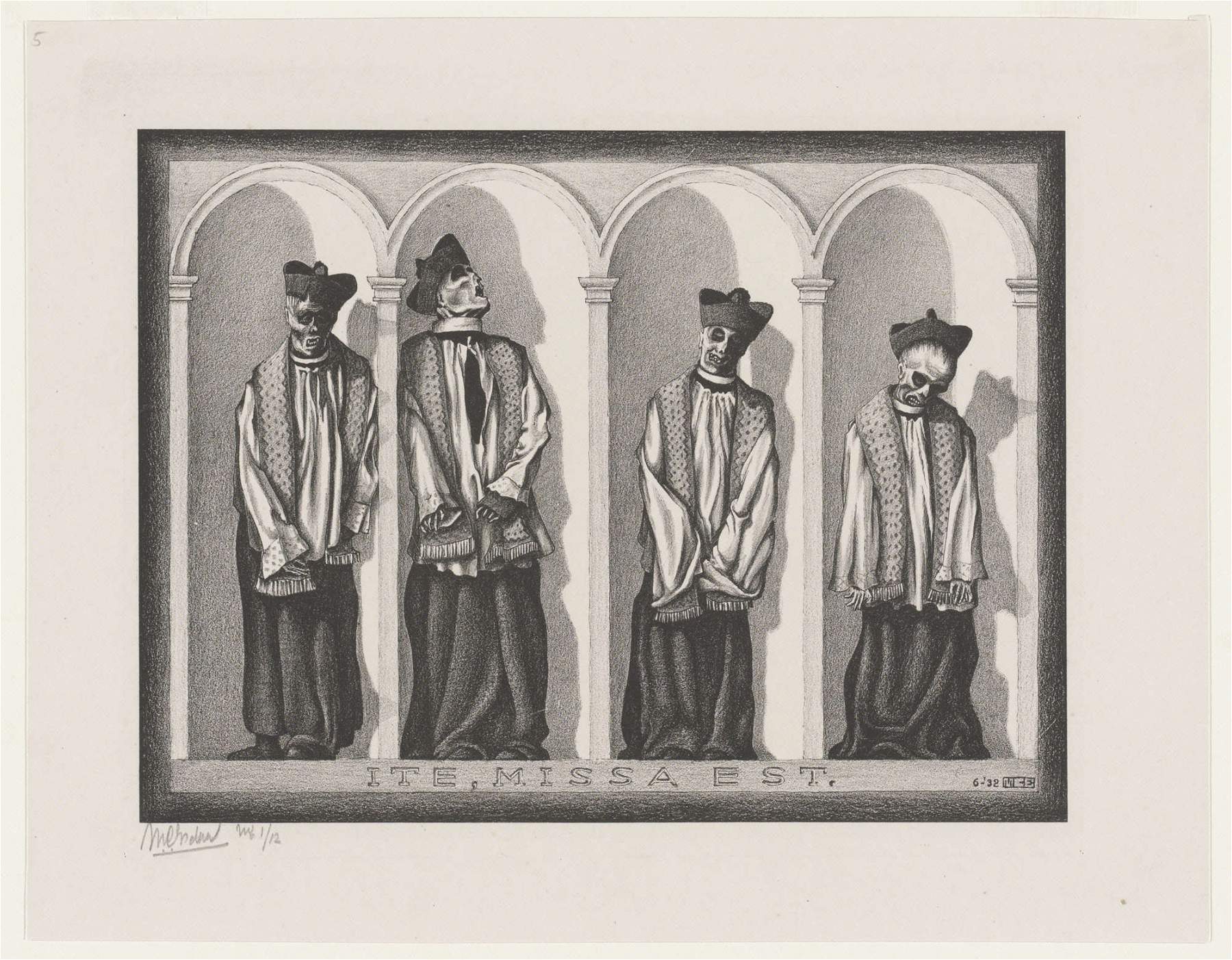
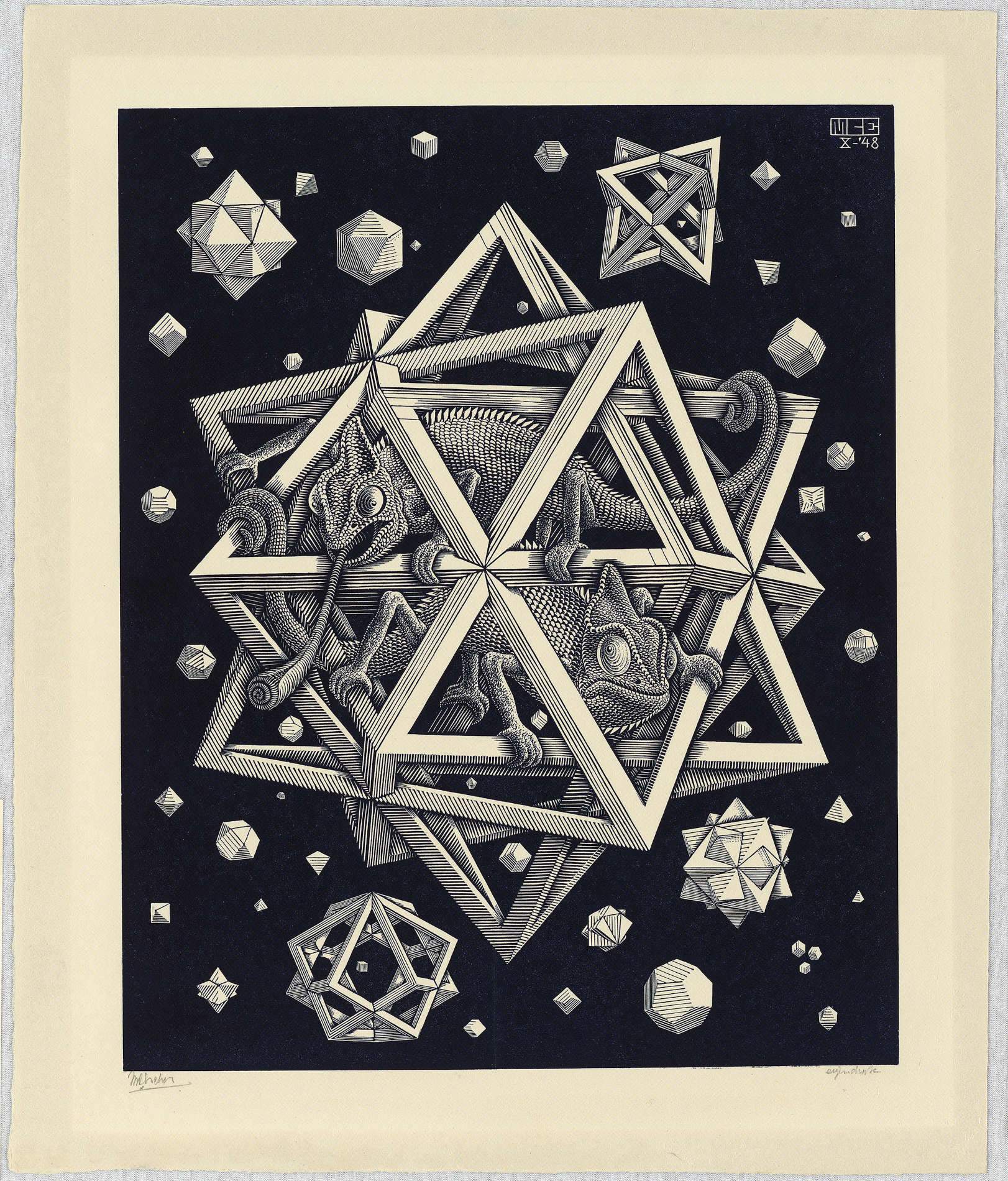
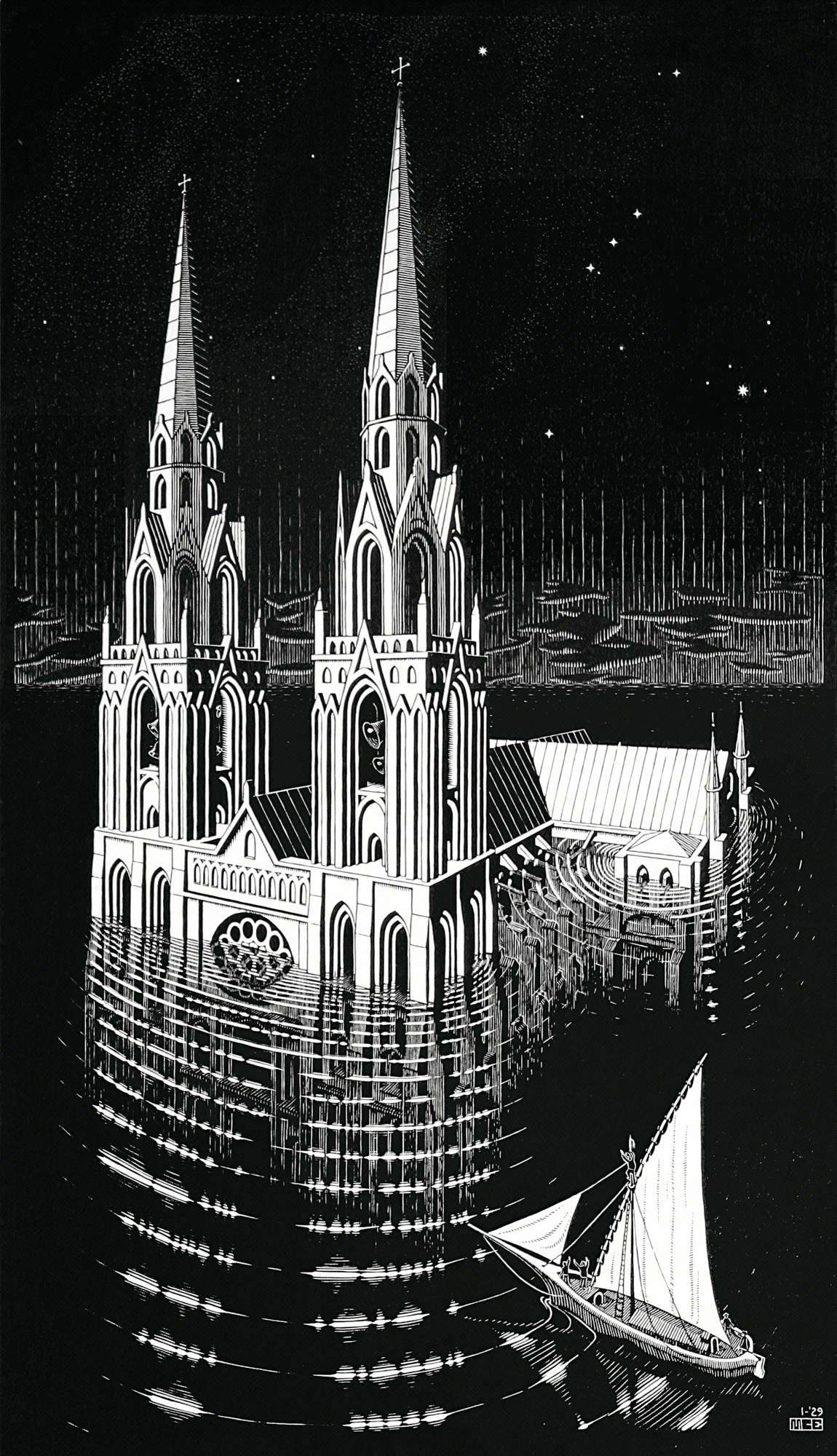
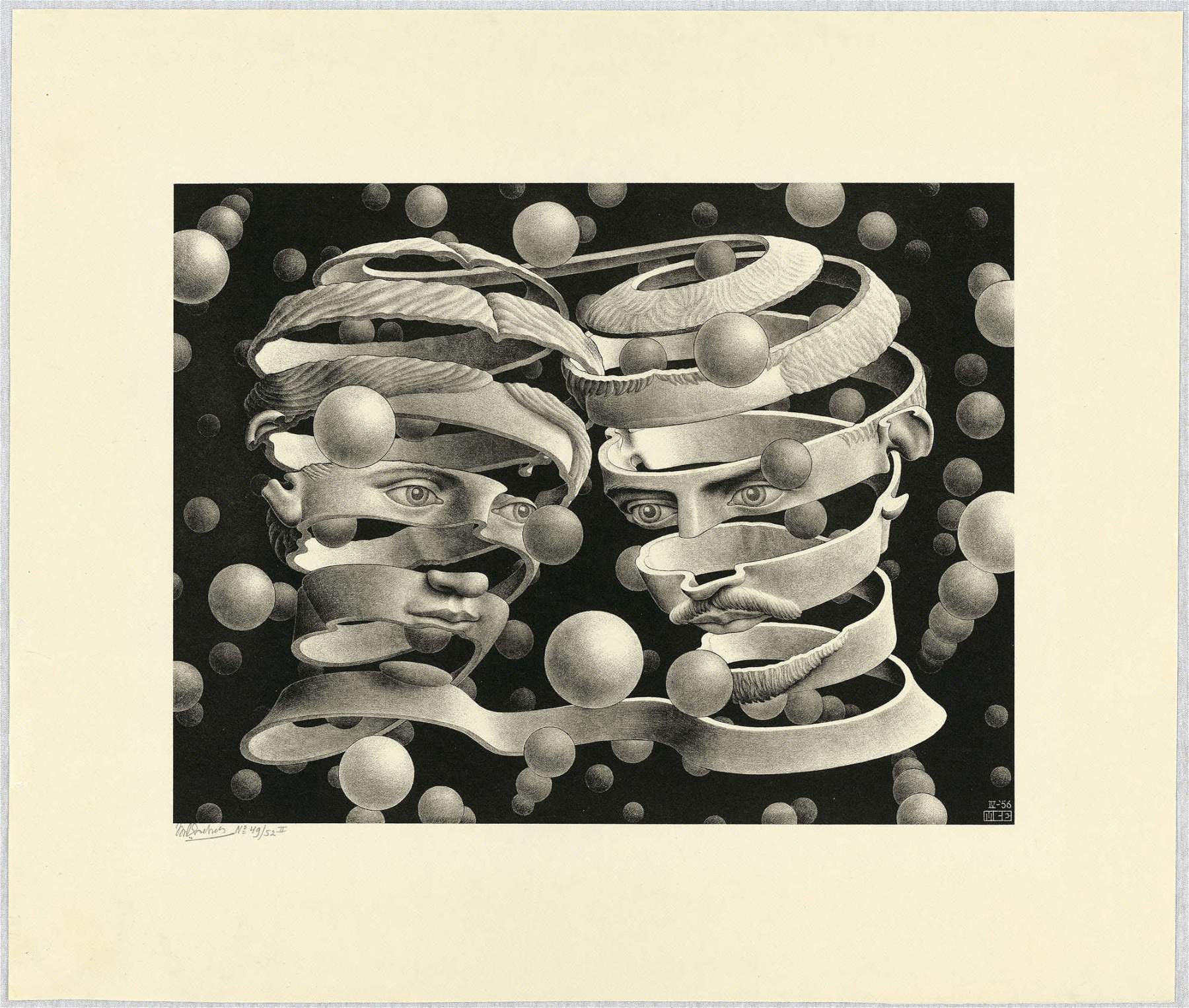
Third Section - Tessellations
In 1936, Escher stayed in Granada, Spain, where he again visited the Alhambra, a fortified palace complex built between the 13th and 14th centuries on the hill overlooking the city by the Nasrid emirs, famous for the elaborate decoration of the buildings. This visit turned out to be a turning point in his career; the elaborate geometric decorations in the Moorish style fascinated him and got him interested in tessellations. In geometry, tessellations are said to be the ways of subdividing the plane with one or more geometric figures repeated endlessly without overlapping or leaving empty spaces. Such geometric figures, called “tessellations,” are often polygons, regular or not, but they can also have curvilinear sides. Seventeen different types of symmetries have been identified to subdivide the plane. Of these symmetries, Escher formed a catalog of 137 watercolors, numbered and filed according to his own logical scheme, to be used as motifs to perform tessellations and metamorphoses. As we shall see, the use of tessellations would become a hallmark of his art, in which fantasy, geometry and figurative subjects are skillfully combined. From this time on, Escher will devote himself, apart from a few sporadic instances, to the representation of abstract, geometrically inspired, paradoxical or illusory scenes.
Fourth section - Metamorphosis
tessellations form the basis of cycles and metamorphoses, the theme of which Escher tackles beginning in 1937. For Escher, a metamorphosis, meaning from the Greek a transformation, specifically a transformation of one being or object into another of a different nature, in fact takes its starting point from the modification and subsequent concatenation of several tessellations (a procedure of regular division of the plane). Escher thus creates a world in which different figures give rise to swirls of transformations of abstract forms into animate forms and vice versa. The woodcut Metamorphosis II (1939-1940), one of his masterpieces, is a circular universe in which a lizard can gradually become the cell of a beehive or a fish transform into a bird which in turn turns into a cube and then a roof, etc. Sometimes antithetical but complementary elements interact in metamorphoses, such as day and night or good and evil, interweaving opposites within the same composition. The study of tessellations and the realization of cycles and metamorphoses (which, by the way, can coexist in the same print, as in Cycle, Day and Night, Reptiles, or Encounter again) induce in Escher the desire for the representation of the unlimited through the infinite subdivision of the plane. He will succeed formally thanks to the insights provided by geometry scholar H.S.M. Coxeter, in the works Limits of the Circle I-II-IV.
Fifth section - Structure of Space.
From his earliest works, even more than for the pictorial element, Escher shows a special attention to the organization of compositional space. As we have seen from the mid-1930s, Escher will gradually break away from the Euclidean representation of space. His growing interest in mathematics and geometry came through his study and fascination with spheres, reflective surfaces, geometric solids, or even topological surfaces such as the Möbius strip, an object perceived as a two-sided surface but which, upon closer observation, demonstrates only one. We could paraphrase one of his comments on the 1935 lithograph Hand with Reflecting Sphere, one of his most famous works, in this way: the sphere, reflecting it, encloses within itself the whole of the surrounding space, at the center of which stands out the very one who looks at it; man is thus the center of this universe. Escher here does not disguise a certain irony about the artist’s ego, immortalized in a self-referential dynamic. The examination of these concepts will lead Escher to exacerbate his taste for the paradoxes, perspective distortions and optical illusions that these figures allow.
Sixth section - Geometric Paradoxes
Escher’s mathematical knowledge was primarily visual and intuitive. His geometric architectures and compositions were characterized by perspective distortions that, at first glance, appeared to be perfectly plausible but, upon closer inspection, proved impossible. An important turning point came in 1954, when some of Escher’s prints were exhibited during the International Congress of Mathematicians in Amsterdam. From that moment on, his work was increasingly appreciated by the scientific community, and the artist began a close dialogue with mathematicians and crystallographers that proved to be a vast source of inspiration for his research on impossible structures, optical illusions and the representation of infinity. This section explores how Escher tried to force beyond all limits the representation of impossible,seemingly coherent situations through a selection of some of his most famous works: Rising and Falling, Belvedere, Waterfall, Gallery of Prints, or even Relativity. These masterpieces reflect an essential aspect of the Dutch graphic artist’s art: his complex relationship with mathematics, geometry, and the theme of the graphic reproduction of infinity.
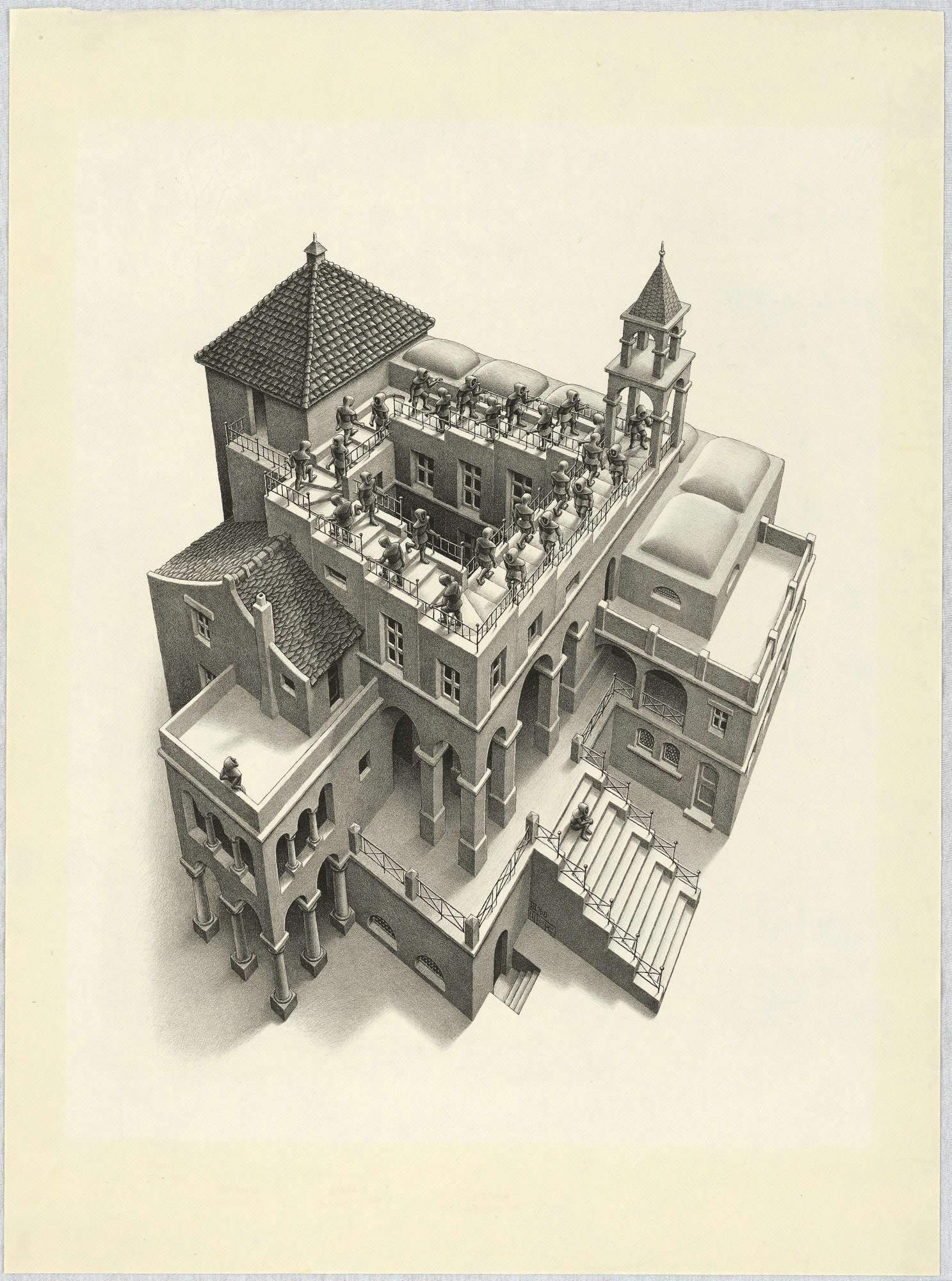
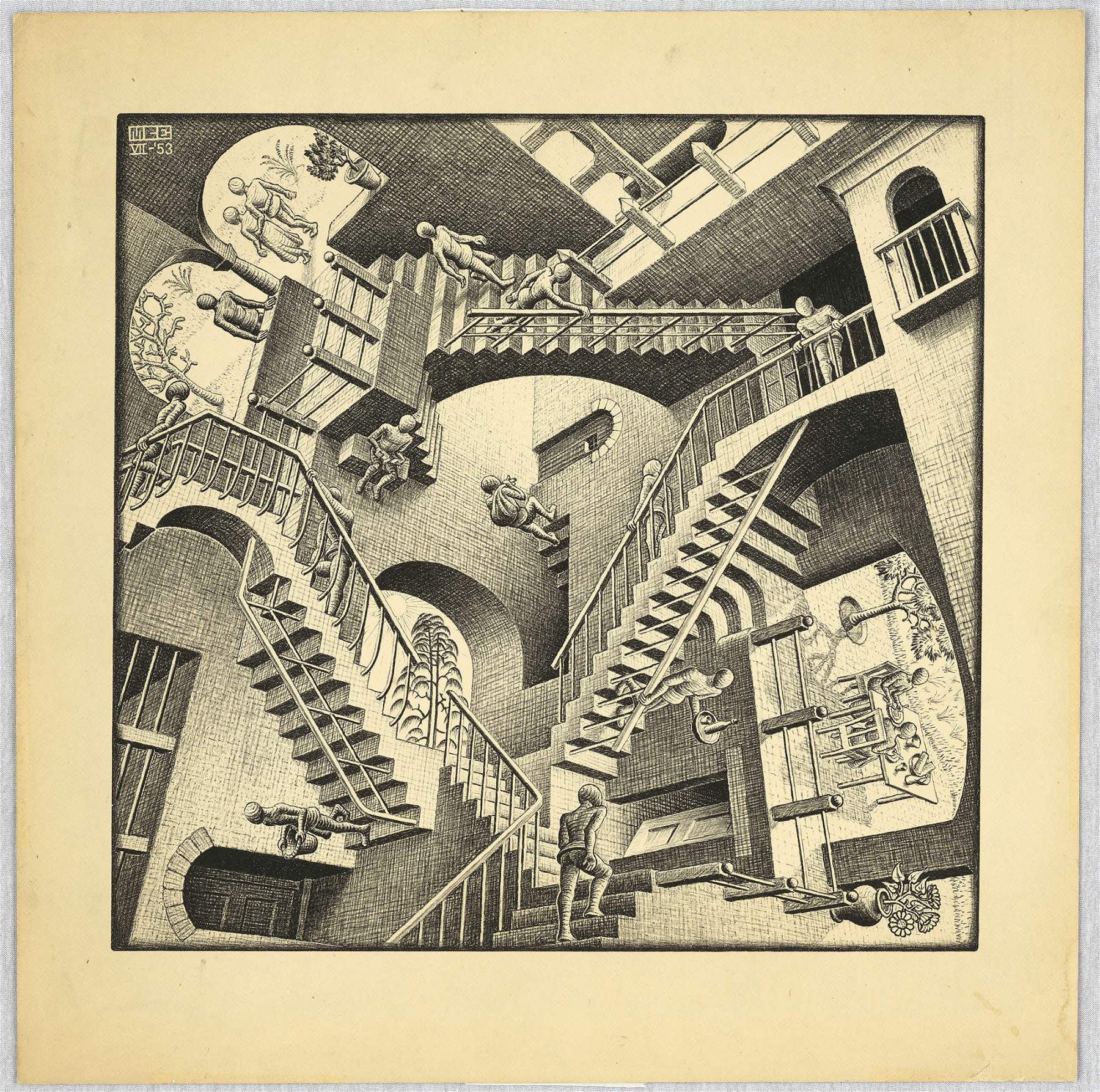
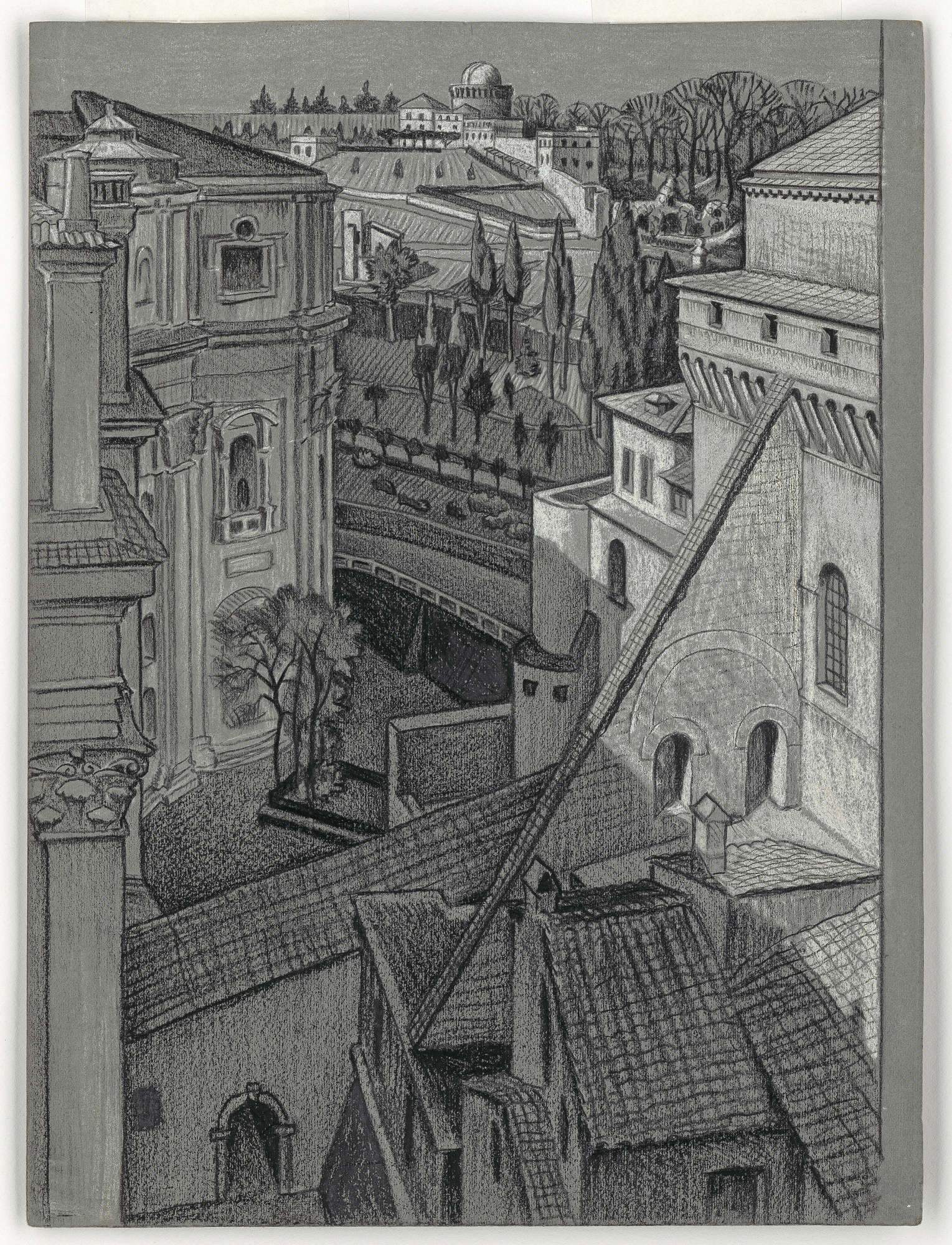
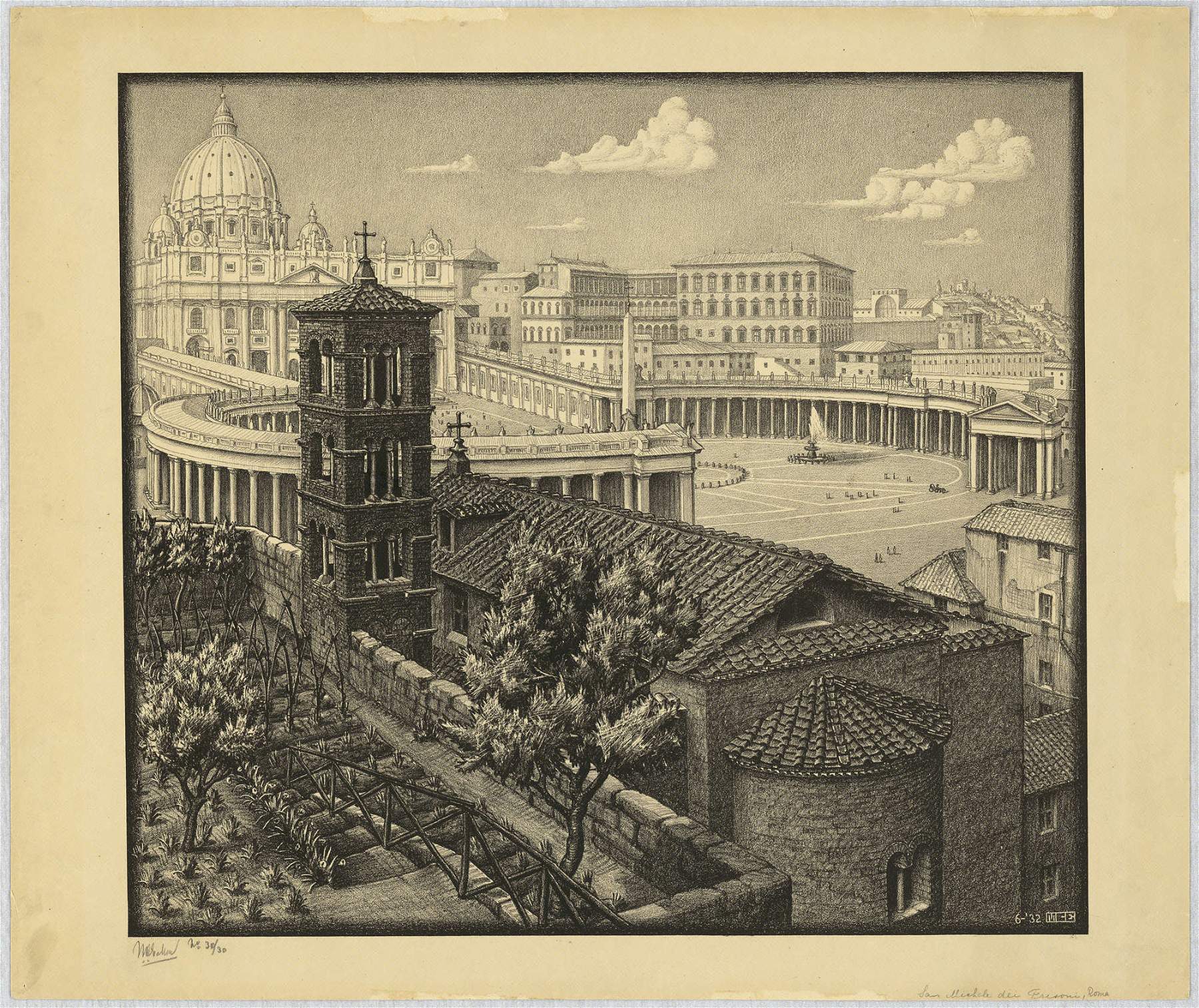
Seventh section - Commissioned works
Like all artists who make a living from their work, Escher, as a graphic artist, received commissions of various kinds over the years. In this section we find a roundup of some of these works: ex libris (markings to be inserted into books in private collections or libraries to attest ownership and prevent their loss or exchange for identical copies), greeting cards, or even designs for logos, stamps, advertising items, etc. For these works, Escher makes extensive and skillful use of tessellations, which are not only a characteristic trait of his, but also lend themselves perfectly to use: ideal for optimizing the time of the creative process through the repeated use of the same figurative element.
Eighth section - Eschermania
From the 1950s onward, Escher’s popularity grew. Thanks in part to his connections with the scientific and academic world, various journals began to devote articles and reviews to him. From the mid-1960s, moreover, in spite of himself, a great deal of visibility will be offered to him, especially in the United States, by the hippy movement, which will appropriate his works, modifying them and reproducing them on posters and T-shirts, in a psychedelic key. This eighth and final section presents a series of artworks and objects that show how Escher was not only an artist who was a child of his time, but also how, up to the present day, through his avant-garde work and his current language, he still exerts a strong influence on the creative process of many artists, musicians, advertisers and cartoonists, to name a few. Certainly his passion for tessellations as well as the creation of impossible and paradoxical ways have not yet ceased to be a source of inspiration for further developments and reworkings, in the most diverse fields.
The exhibition, under the patronage of the Lazio Region, the Municipality of Rome - Department for Culture and the Embassy and Consulate General of the Kingdom of the Netherlands, is produced and organized by Arthemisia in collaboration with the M. C. Escher Foundation and Maurits and is curated by Federico Giudiceandrea - one of the world’s leading Escher experts - and Mark Veldhuysen, CEO of the M.C. Escher Company. The exhibition is sponsored by Generali Valore Cultura, special partner Ricola, mobility partner Atac and Frecciarossa Treno Ufficiale, media partner la Repubblica and Urban Vision, partner Mercato Centrale Roma, and hospitality partner Hotel de Russie and Hotel de la Ville.
The Escher exhibition is part of the project “The Art of Solidarity” carried out with Komen Italia, the exhibition’s charity partner. Combining art with health, beauty with prevention: this is the essence of a project that sees the pink color of Komen Italia merging with the masterpieces displayed in the exhibitions. In concrete terms, a portion of the proceeds from the sale of exhibition tickets will be donated by Arthemisia for the realization of specific projects to protect women’s health. With this partnership Komen Italia closes October, prevention month, and prepares for the big national event to celebrate its 25th year of “Race for the cure” next May 2024.
The catalog is published by Skira.
Information and reservations T. + 39 06 87 15 111 Site www.mostraescher.it www.mostrepalazzobonaparte.it www.arthemisia.it Social and official hashtag @arthemisiaarte @mostrepalazzobonaparte
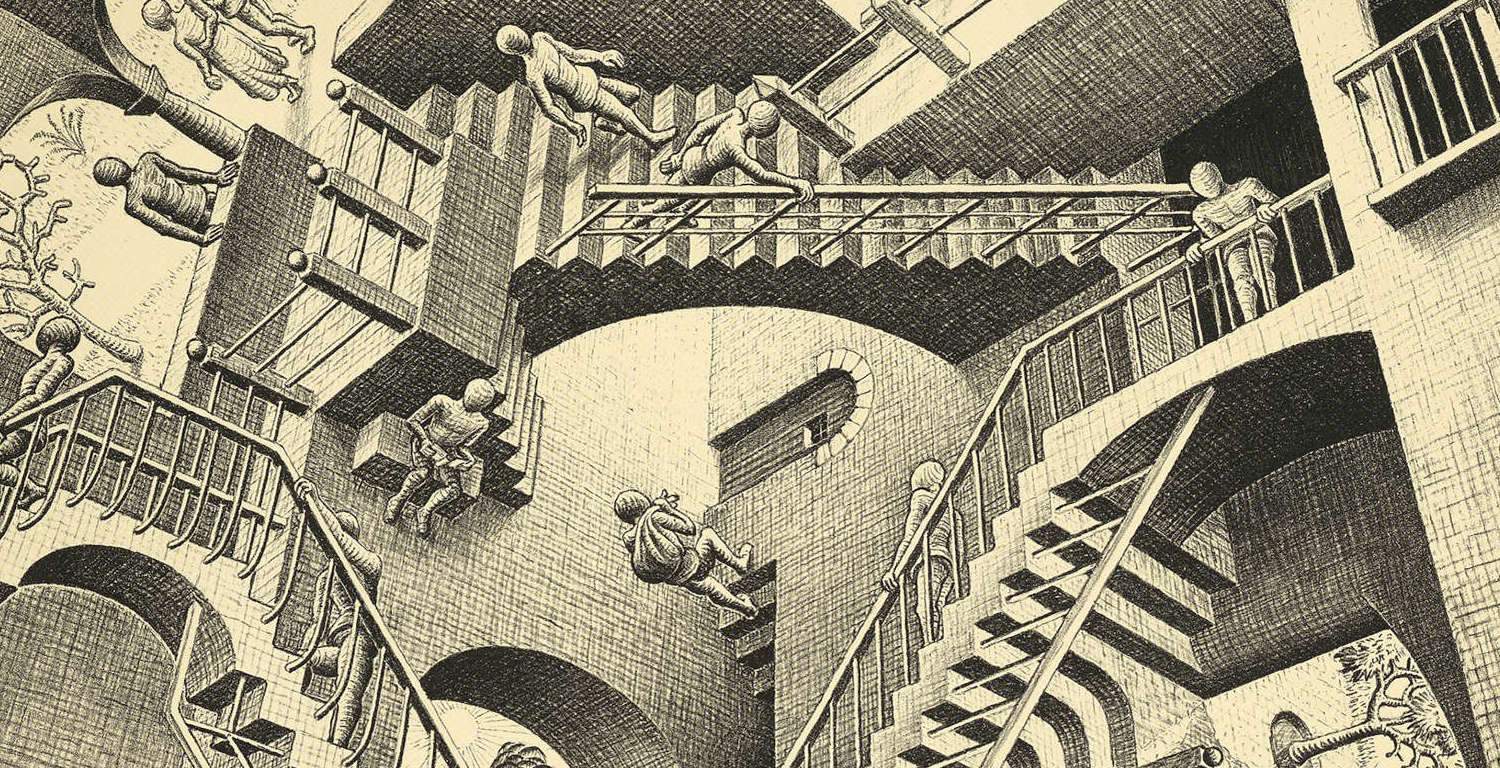 |
| Largest Escher exhibition ever opened in Rome |
Warning: the translation into English of the original Italian article was created using automatic tools. We undertake to review all articles, but we do not guarantee the total absence of inaccuracies in the translation due to the program. You can find the original by clicking on the ITA button. If you find any mistake,please contact us.





























